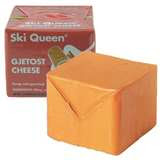 Gorgonzola cheese is produced only in the Lombardy and Piedmont regions of Italy. It is a pasteurized cow's milk cheese with an inedible outer rind. The history of Gorgonzola cheese starts with the town of Gorgonzola in Lombardy where herdsmen rested their cows on the trek back home form their Alpine pastures. Here milk was traded and the surplus converted into cheese. Some of the Gorgonzola that arrives in the US is still made by small artisan dairies but the bulk of the production is made by lager scale facilities in both the Piedmont and Lombardy regions. This cheese comes in two forms Dolce (sweet) and Naturale or Mountain (Spicy). Both forms are made in the same way, the only difference between them is the amount of time that they are allowed to age.
Gorgonzola cheese is produced only in the Lombardy and Piedmont regions of Italy. It is a pasteurized cow's milk cheese with an inedible outer rind. The history of Gorgonzola cheese starts with the town of Gorgonzola in Lombardy where herdsmen rested their cows on the trek back home form their Alpine pastures. Here milk was traded and the surplus converted into cheese. Some of the Gorgonzola that arrives in the US is still made by small artisan dairies but the bulk of the production is made by lager scale facilities in both the Piedmont and Lombardy regions. This cheese comes in two forms Dolce (sweet) and Naturale or Mountain (Spicy). Both forms are made in the same way, the only difference between them is the amount of time that they are allowed to age.
Gorgonzola is made by layering the dried curds form the evening milking and the next mornings milking. The bluing originally occurred naturally in the caves were the cheeses were left to age. Over time it was noticed that by piercing the young cheeses the blue veins would grow more pronounced and that the bluing would proceed faster. Now penicillium gorgonzola is introduced into the curds before they are formed and set out in caves to age. After about one month the young cheeses are pierced with needles to allow oxygen to enter and accelerate the blue veining.
Naturale (mountain) Gorgonzola is aged from 3 to 12 months and has also been washed frequently with brine during the aging process. The longer aging process allows a thicker rind to form that can be handled easier and also creates a dry interior paste along with deep and dark blue veining. The flavor of mountain Gorgonzola will be powerful and spicy with an earthy flavor and the interior paste will be dense but smooth and may have crunchy amino acid crystals. As the cheese ages the darker the interior paste becomes and the stronger the flavor will be. Be forewarned this cheese with have a heavy cheesy aroma but it will not be overly offensive. This cheese will be heavenly for any blue cheese lover.
Italian Cheese Sampler at Amazon
When shopping for Gorgonzola always check to see if the inner paste looks pink or gray or looks dried out or if it is oozy. Be sure to ask for a sample to see which age agrees better with you. Gorgonzola can be purchased online at Amazon or in specialty cheese shops. If you can not find an agreeable Gorgonzola you can substitute Stilton.
Gorgonzola is wonderful crumbled in a garden salad and melted over burgers or roasted potatoes. Mixed with Crème Fraiche it makes an excellent salad dressing.
Italian Cheese Sampler at Amazon
When shopping for Gorgonzola always check to see if the inner paste looks pink or gray or looks dried out or if it is oozy. Be sure to ask for a sample to see which age agrees better with you. Gorgonzola can be purchased online at Amazon or in specialty cheese shops. If you can not find an agreeable Gorgonzola you can substitute Stilton.
Gorgonzola is wonderful crumbled in a garden salad and melted over burgers or roasted potatoes. Mixed with Crème Fraiche it makes an excellent salad dressing.
Wine Pairing: Italian reds like Amorone, Barolo, Brunello,Chianti Reserva, or a Marsala.


















